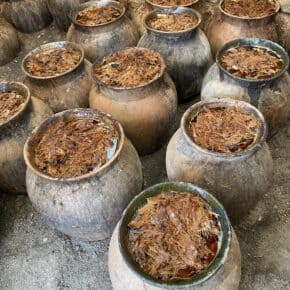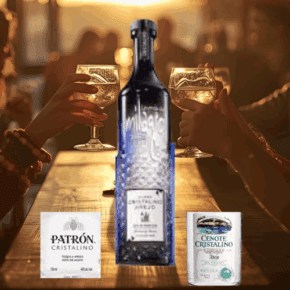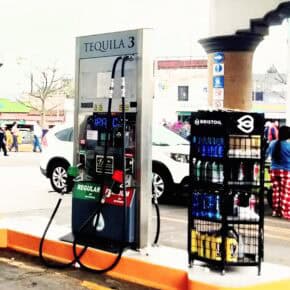In the world of agave spirits, you’ll hear norma, norm, and NOM tossed around a lot in conversation. This can be confusing, but it’s not that complicated—unless you start reading the fine print. NOMs are sets of rules that govern Mexican industries–in other words, the established norms. (Normas in Spanish.) Tequila has a NOM, as do mezcal, bacanora, and sotol. Raicilla will supposedly have one soon.
What does a NOM do? While a denomination of origin (DO) establishes where a spirit can be produced in Mexico, the NOM gets into the specifics of how it should be produced.
The tequila NOM is the blueprint for the regulation of Mexican spirits. NOM-006 defines tequila and lays out the rules that govern the entire process–from field to shelf. For example, the norma describes the two categories of tequila (mixto and 100% agave) and the five classes of tequila (blanco, reposado, añejo, extra-añejo, and oro). But it also gets very detailed about the allowable range of chemical properties in tequila and the acceptable processes for producing, bottling, labeling, and selling tequila.
What is the mezcal norm?
NOM-070 has stipulated the official rules of the mezcal game since the DO was established in 1994. As with the tequila norm, NOM–070 defines mezcal. The norma specifies the allowable range of chemical properties in certified mezcal and the hoops producers must jump through in order to be compliant. It outlines the categories of mezcal (joven, reposado, and añejo) and the agaves that may or may not be used to make mezcal.
From the get-go, many producers resented the mezcal norm, stating it was lazily copied from the tequila norm without taking into account the vastly different factors at play in mezcal culture, geography, and production. The general consensus was that the norm was designed to make room for an industrial model that was at odds with the values and traditions of small producers.
In 2017, the mezcal NOM was overhauled–with mixed reviews. (Many mezcal producers continue to resent the norms and are opting out of the system, which is why we’re seeing more destilados de agave or seemingly generic “agave spirits.”)
What about the other booze? Do sotol, raicilla, and bacanora have their own norms?
In 2004, NOM-159 set the rules for sotol. The following year, NOM-168 was ratified for bacanora. Raicilla has a DO, but the government hasn’t yet ratified the proposed norma. All three of these norms follow the tequila blueprint, although they vary, predictably, in terms of production methods, types of agave allowed, and how much agave (or sotol) is required. For example, while bacanora must be 100% agave, sotol may be only 51% Dasylirion.
Who enforces the rules?
Tequila is regulated by the famously stringent Tequila Regulatory Council (CRT). What do we mean by stringent? The CRT uses satellite imaging to monitor agave fields. Farmers must submit a report categorizing every plant as healthy, sick, or harvested.* The CRT also regularly inspects distilleries and requires that every batch of tequila be analyzed in a CRT-approved lab.
The CRT is often mistaken for a government agency, when it is in fact a nonprofit–a very aggressive nonprofit.
The scene is similar with mezcal, albeit with a relatively recent dust-up. All commercial mezcal was once regulated by another nonprofit agency, which was once commonly called the CRM, but now calls itself COMERCAM (Mexican Regulatory Council for Mezcal Quality). COMERCAM’S hegemony was disrupted in 2018, when the government approved several other organizations to certify mezcal. This didn’t go over well with COMERCAM, and the situation continues to be complicated. That said, 96% of mezcal is still certified by COMERCAM. (According to COMERCAM).
The Mexican Sotol Council and the Sotol Certificate Council (CCS) are charged with regulating sotol.
In the case of bacanora, the answer may be “We’re not sure who, if anyone, is enforcing the rules at the moment.” In contrast to the rigor of the CRT and COMERCAM, the bacanora norm has only been enforced sporadically.
But wait, what are NOM numbers on tequila and mezcal?
Okay, we lied. This IS complicated. When people talk about NOMs, they are often actually not talking about the set of rules that govern production, but rather referring to a number that appears on every bottle of tequila or mezcal. You’ll find these numbers next to the official NOM stamp and thus aficionados may call them the “NOM number” or “the NOM.” The government issues these numbers to producers, which allows savvy aficionados to figure out which distillery is making a given brand. Usually. However, the government may also issue NOMs to “business entities,” which means, for example, that various tequilas with different NOMs could be made at the same distillery.* Typically, however, NOM numbers are useful for figuring out which producer is behind a brand.
Bibliography:
*A Field Guide to Tequila, Clayton Szczech, Hatchette Book Group (2023)
Divided Spirits: tequila, mezcal, and the politics of production, Sarah Bowen, University of California Press (2015)
“What’s going on with COMERCAM,” Susan Coss, Mezcalistas, (2021)
“Diving into 2023 mezcal production numners,” Susan Coss, Mezcalistas, (2024)












Leave a Comment